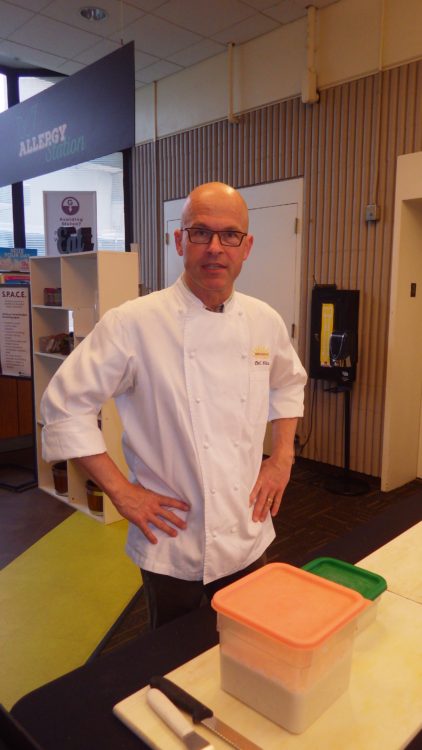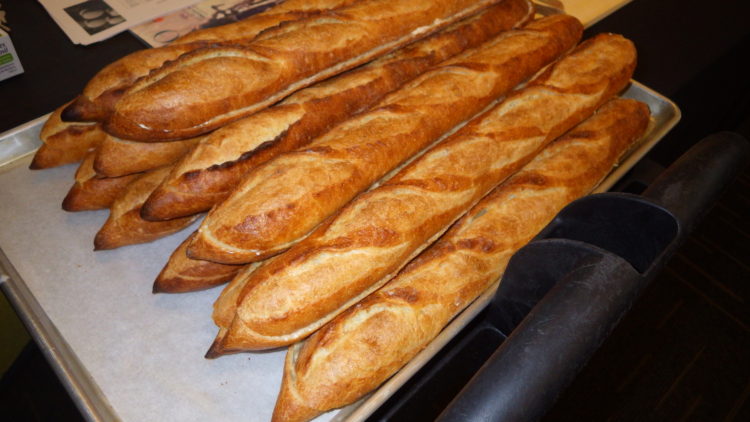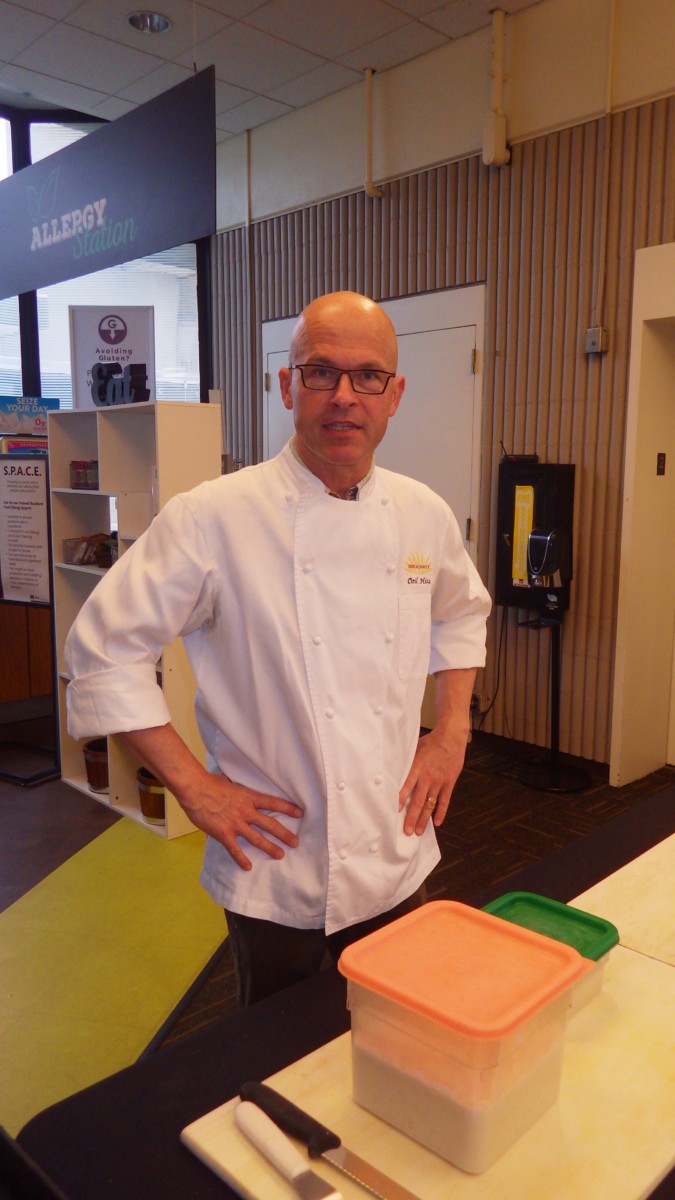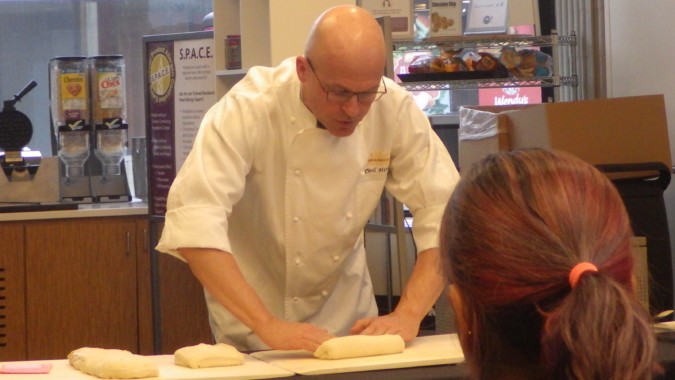Or in my case, “How to Flour Your Kitchen”.
He said the dough shouldn’t argue with you when you roll it into a baguette. Well, in the past I’ve had a full on screaming match with mine.
I attended the Boivin Center for French Language and Culture’s program The Art of Baking Bread with Chef Ciril Hitz on April 27that UMASS Dartmouth. Chef Hitz is an accomplished and award winning master baker, and a full time instructor at Johnson and Wales University in Providence. He also hosts artisan bread and pastry workshops at Breadhitz, his bakery and home in Rehoboth. The program drew a good crowd, almost 100 people, men and women, as well as a couple of youngsters (one looking dapper in a snazzy bow tie). While not participant hands-on, the instruction and interaction were excellent, and Hitz’s conversation with the audience very productive. He didn’t dumb it down, his expectation was that most knew something about baking bread and perhaps there were even some pros in the audience.
I have made stabs at bread baking over the years, and while the results were okay they were never stellar, so I was interested to perhaps learn what I’d been messing up for so long. Bread baking, to me anyway, has always been like making a soufflé; one misstep and it’s all over. Too hot, too cold, too moist, too dry, wrong yeast, old flour, is tap water okay? It can be crazy-making. But Chef Hitz was refreshing in his attitudes and his approach fairly aggressive, his mantra being “Bake Bold!”
What was he going to teach us to bake? What he referred to as “the baker’s nightmare”, the baguette. Great.
Chef Hitz is funny, unassuming, engaging and informative. He is Swiss: German, not French speaking, which may explain his straight-faced humor. He was very forthcoming about his feelings on breads from other countries. Northern Italians bore the brunt of it with his disdain of white-colored uninteresting bread. I couldn’t disagree; it was more about what went ON the bread in Venice, than the bread itself.
Being Swiss he lamented the United States’ poor decision to not switch to metric measures. His recipes provided measurements in grams, and he was adamant the best baking is done with a scale, not measuring cups and spoons. Another must have? An instant-read thermometer to take the temperature of the dough along the way. That was an “ah ha!” moment for me. He also recommended the ingredients he uses; King Arthur All Purpose Flour (I heartily agree), fine crystalline salt, SAF Instant Yeast, and diastatic barley malt powder. Now that’s something I’d never used before. It’s for caramelization; if there is no sugar in the loaf there will be no color to it. He called it bread doping, only legal. He also said water wouldn’t have a drastic effect on the outcome unless it was heavily chlorinated, and airing it out before use would help. He promoted using local stuff to make good bread, the blossom where you’re planted rule. Again, refreshing.
He also said that baking should be done in a very hot oven, like 500 degrees hot. And a steamed oven, with a cast iron pan in the bottom during the pre-heating that gets a hit of water when the oven comes to temperature, and another one once the bread is loaded into the oven.
The recipe itself included a poolish (rhymes with leash), or a preferment. According to the King Arthur Flour website: “A preferment is a preparation of a portion of a bread dough that is made several hours or more in advance of mixing the final dough.” Another “ah ha!” moment for me. He’d premade his dough so he could demonstrate the stretching, folding, shaping and cutting so we’d know what to do when we got home. Thankfully he has a YouTube video that I could watch as I went along. He said the dough shouldn’t argue with you when you roll it into a baguette. Well, in the past I’ve had a full on screaming match with mine. Not so much this time. We’d achieved détente. Albeit with a heavily floured kitchen. Danke schoen, Chef!
Baguette with Poolish
Poolish:
200 grams All Purpose Flour
200 grams 70 degree water
A pinch of instant yeast
Blend the poolish ingredients together to a smooth consistency
Cover so no crust can form
Allow to ferment at room temperature overnight
Dough:
400 grams All Purpose Flour
200 grams 87-90 degree water
1.6 grams instant yeast
12 grams salt
4 grams diastatic malt powder
All of the poolish
In a stand mixer fitted with a dough paddle mix all of the ingredients on 1stspeed for 4 minutes. Increase to 2ndspeed for 1 minute.
Place dough in an oiled bowl making sure its internal temperature is 75 degrees. If not, place it in a warm environment until that temperature is achieved. (Luckily my oven has a proof setting, as my house is never that warm)
Proof for 45 minutes and give the dough a stretch and fold. Proof another 45 minutes and then divide the dough into 4 equally weighted sections. Preshape (go to breadhitz.com’s YouTube channel for detailed instruction), cover with plastic and let rest 20 minutes.
Shape the baguettes and couche them (use a linen dishcloth if you don’t own a couche) for 40-50 minutes on a flour dusted surface, seam side up.
Preheat the oven to 500 degrees with a cast iron pan on the bottom and the oven rack in the middle. Once to temperature spray water into the pan to steam the oven.
Put the loaves on a baking/pizza stone far enough apart for even browning, and score the tops of the bread with a razor or lame (a fancy name for a bread scoring tool). Once the bread is in the oven add water to the cast iron pan again.
Bake for a minimum of 20-25 minutes. To test for doneness squeeze the loaf to see if there is a crunch.
Click on image to view full size
I’ve added my notes above after actually making the recipe at home. My takeaways? This makes a lotta bread. And since Chef Hitz wants us to eat it, all of it, immediately I may need to cut this recipe in half. Also, my pizza stone isn’t big enough as I ended up with the dreaded zebra stripes on the sides of my loaves. I need some additional tools like transfer boards and a good lame if I want to do more of this. I’m sure I’ll be finding flour in places I’ve never considered. And it’s a long process. I did get good fermentation with irregular sized holes in the interior, and the bread was wonderful. But I wonder if he shared thisrecipe so we’d all just go buy his bread instead? Hmm.

This article was originally published in The Standard Times, May 6, 2018
























love it!!! and always, only King Arthur flour! the best! love how you referenced them 🙂